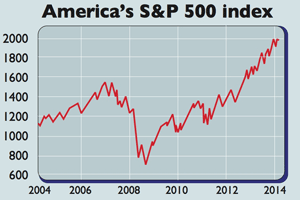
The bears “have gone into hibernation”, say Alexandra Scaggs and Steven Russolillo in The Wall Street Journal. America’s S&P 500 stock market index has hit a new record above 2,000.
The bull is based on “endless free money”, as Randall Forsyth notes in Barron’s – all the world’s major central banks have adopted zero-interest-rate policies, and this ample liquidity has allowed investors to ignore high US valuations, a weak global recovery, and ominous geopolitics.
Now, rather than worry about whether the market is due a breather, Wall Street is working on “a new rationale for optimism”, says John Authers in the Financial Times.
The bulls note that periods of rising rates have done equities no harm in the past – ignoring the fact that this time the world economy is carrying an unprecedented level of debt. The bulls also point to a new note from Morgan Stanley arguing that the S&P could hit 3,000 in the next five years.
Morgan Stanley’s point is that the global and US economic recoveries are likely to last for considerably longer than usual. The global economy “is out of sync, with countries in different stages of their cycle”. So it is nowhere near overheating.
Similarly, while the US recovery has already lasted for more than five years – longer than the post-World War II average – it could go on for another five to become the longest ever. The “repair phase” of the cycle, when the economy gets over the damage caused by the last slump and gets ready to motor, has only just ended.
US households have cut debt as a share of disposable income from a peak of 135% to 108%, and consumer confidence has finally risen to levels seen in a normal recovery.
Companies have refinanced and cut their borrowing too, and so “remain far from” overstretched. Capital spending has only recently started to grow in earnest.
“As the prolonged expansion becomes more visible, we’d expect a materially higher US stock market” – assuming that the recovery can avoid being derailed by a global crisis or a Washington-induced fiscal squeeze.
All the same, investors should be wary of rampant bullishness on Wall Street. When everyone agrees that stocks are going up, “it’s dangerous”, says Jim Cahn of the Wealth Enhancement Group. “If they turn out to be wrong, everyone runs for the door at the same time.”